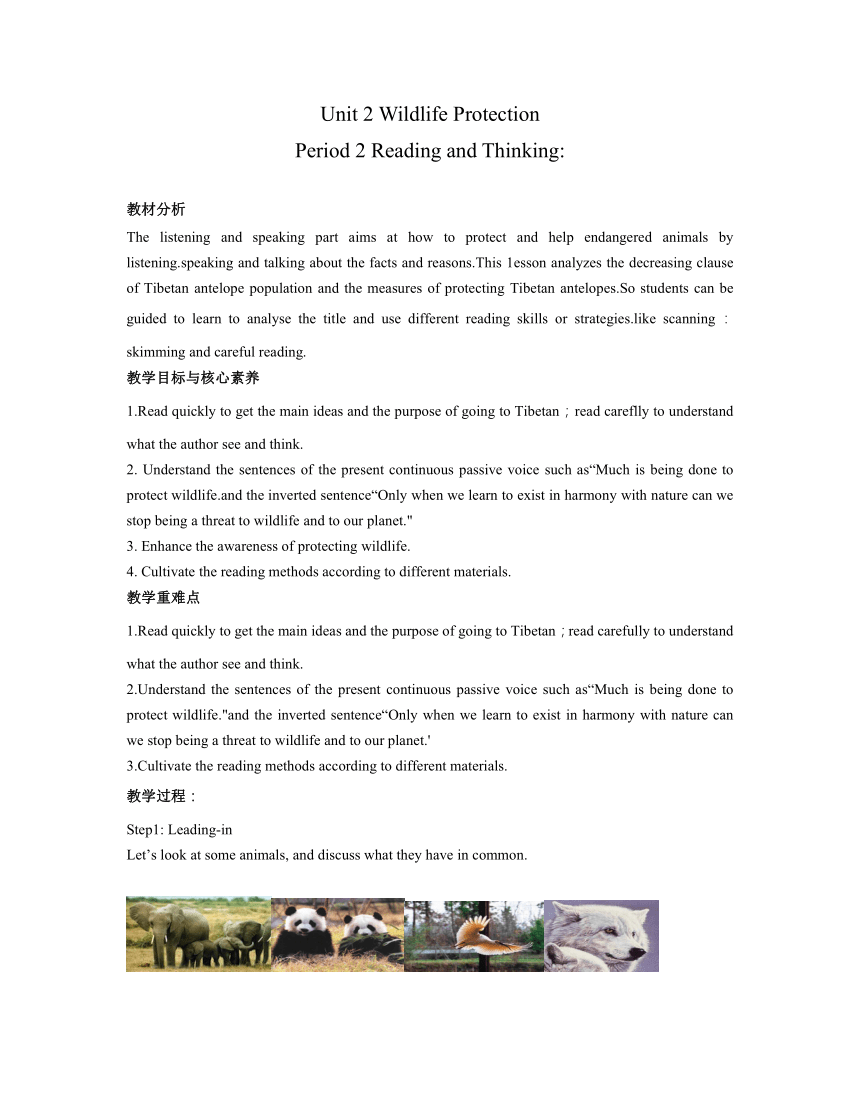人教版(2019)必修第二册 Unit2 Wildlife Protection Period2 Reading and Thinking教案
文档属性
| 名称 | 人教版(2019)必修第二册 Unit2 Wildlife Protection Period2 Reading and Thinking教案 |  | |
| 格式 | docx | ||
| 文件大小 | 1.6MB | ||
| 资源类型 | 教案 | ||
| 版本资源 | 人教版(2019) | ||
| 科目 | 英语 | ||
| 更新时间 | 2022-11-06 19:45:18 | ||
图片预览

文档简介
Unit 2 Wildlife Protection
Period 2 Reading and Thinking:
教材分析
The listening and speaking part aims at how to protect and help endangered animals by listening.speaking and talking about the facts and reasons.This 1esson analyzes the decreasing clause of Tibetan antelope population and the measures of protecting Tibetan antelopes.So students can be guided to learn to analyse the title and use different reading skills or strategies.like scanning:skimming and careful reading.
教学目标与核心素养
1.Read quickly to get the main ideas and the purpose of going to Tibetan;read careflly to understand what the author see and think.
2. Understand the sentences of the present continuous passive voice such as“Much is being done to protect wildlife.and the inverted sentence“Only when we learn to exist in harmony with nature can we stop being a threat to wildlife and to our planet."
3. Enhance the awareness of protecting wildlife.
4. Cultivate the reading methods according to different materials.
教学重难点
1.Read quickly to get the main ideas and the purpose of going to Tibetan;read carefully to understand what the author see and think.
2.Understand the sentences of the present continuous passive voice such as“Much is being done to protect wildlife."and the inverted sentence“Only when we learn to exist in harmony with nature can we stop being a threat to wildlife and to our planet.'
3.Cultivate the reading methods according to different materials.
教学过程:
Step1: Leading-in
Let’s look at some animals, and discuss what they have in common.
Step2:pre-reading
What is the animal
Step3: While-reading
Skimming
Read the passage quickly to answer the following questions.
(1) Why did the author come to Tibet
(2) Why did the population of antelopes drop so badly in the 1980s and 1990s
(3) What was done to protect the Tibetan antelopes
(4) Why should we continue the protection programs of the antelopes
(5) What can we do to save the planet according to the author
Scaning
2. Read the passage and fill in the blanks.
Careful Reading
1. Read quickly and figure out the main idea of each paragraph.
Paragraph 1:
Paragraph 2:
Paragraph 3:
Paragraph 4:
Paragraph 5:
Paragraph 6:
Paragraph 7:
2. What does the author experience in the clouds
Things the author sees:
Things the author hears:
Things the author feels or thinks:
3. As students, what should we do to protect the wild animals
4. What’s the purpose of this article
Step4: Summary
Step5: Homework
Please prepare a short speech:
Tell us the dangers antelopes are facing.
Call on our classmates to protect these animals.
Period 2 Reading and Thinking:
教材分析
The listening and speaking part aims at how to protect and help endangered animals by listening.speaking and talking about the facts and reasons.This 1esson analyzes the decreasing clause of Tibetan antelope population and the measures of protecting Tibetan antelopes.So students can be guided to learn to analyse the title and use different reading skills or strategies.like scanning:skimming and careful reading.
教学目标与核心素养
1.Read quickly to get the main ideas and the purpose of going to Tibetan;read careflly to understand what the author see and think.
2. Understand the sentences of the present continuous passive voice such as“Much is being done to protect wildlife.and the inverted sentence“Only when we learn to exist in harmony with nature can we stop being a threat to wildlife and to our planet."
3. Enhance the awareness of protecting wildlife.
4. Cultivate the reading methods according to different materials.
教学重难点
1.Read quickly to get the main ideas and the purpose of going to Tibetan;read carefully to understand what the author see and think.
2.Understand the sentences of the present continuous passive voice such as“Much is being done to protect wildlife."and the inverted sentence“Only when we learn to exist in harmony with nature can we stop being a threat to wildlife and to our planet.'
3.Cultivate the reading methods according to different materials.
教学过程:
Step1: Leading-in
Let’s look at some animals, and discuss what they have in common.
Step2:pre-reading
What is the animal
Step3: While-reading
Skimming
Read the passage quickly to answer the following questions.
(1) Why did the author come to Tibet
(2) Why did the population of antelopes drop so badly in the 1980s and 1990s
(3) What was done to protect the Tibetan antelopes
(4) Why should we continue the protection programs of the antelopes
(5) What can we do to save the planet according to the author
Scaning
2. Read the passage and fill in the blanks.
Careful Reading
1. Read quickly and figure out the main idea of each paragraph.
Paragraph 1:
Paragraph 2:
Paragraph 3:
Paragraph 4:
Paragraph 5:
Paragraph 6:
Paragraph 7:
2. What does the author experience in the clouds
Things the author sees:
Things the author hears:
Things the author feels or thinks:
3. As students, what should we do to protect the wild animals
4. What’s the purpose of this article
Step4: Summary
Step5: Homework
Please prepare a short speech:
Tell us the dangers antelopes are facing.
Call on our classmates to protect these animals.
